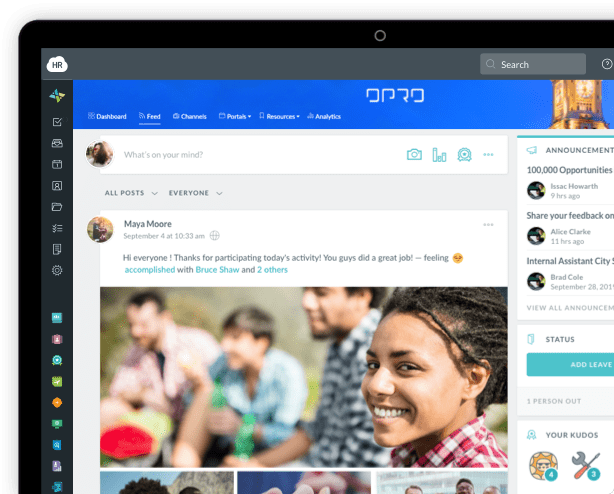How OKRs Make Remote Working More Productive and 5 Steps to Implement Them

In the wake of the Covid-19 pandemic, the world of work faced a major shift from office-bound to remote-working conditions. Not just a temporary situation, this shift is here to stay permanently. By 2025, about 70% of the workforce will be working remotely at least five days a month. This is because remote working has its perks, from employees feeling happy to them saving money (and the environment) by not commuting.
But that’s just one side of the coin. The other side is when distributed teams and companies face remote-working problems like misalignment and lack of visibility on progress. One of the best ways to make sure that teams and companies benefit from productive remote working lies in OKR (Objective and Key Result)—a scalable goal alignment and tracking system.
Common Remote-Working Problems
But first, let’s see what are the usual problems that occur when companies adopt remote working.
Limited visibility on progress
With employees not being physically present in the workplace, remote work can make monitoring progress—whether it’s individual, team, or project progress—tricky. Remote staff may feel left out and not reach out when faced with blockers. Employers, on the other hand, are faced with the difficult task of checking in without micromanaging.
Misalignment with company initiatives
Out of sight, out of mind; and sometimes out of sync too. Teams and employers may fall out of alignment during the shift to remote work. It’s no longer as easy as popping into a colleague’s cubicle to sync up on a project. When left unsolved, misalignment snowballs into bigger problems like frequently missed deadlines and poor cross-team collaboration.
Low motivation level
Without the usual workplace shenanigans (i.e., water cooler chats) that promote socialization and healthy teamwork, remote staff can be plagued by isolation and loneliness. They may end up wondering how their daily tasks will contribute to the company’s overall goals.
To mitigate these problems, it helps to set and track goals so that company-wide folks are driven to work together in the right direction with constant progress, even throughout remote-working conditions.
How OKR Makes Remote Working More Productive
One good goal-setting system is OKR—a scalable goal-tracking system that was influenced by Peter Drucker’s Management by Objectives. First rolled out at Intel, OKR is now used by many remote-based companies like Google, Atlassian, and LinkedIn. OKR has six major components which are:
Objective
The goals that can motivate teams to do their best and right work. Each team should have five objectives at most.
Key Result
Quantitative metrics used to measure if the objectives are met. Each objective should have five key results at most.
|
Here’s a sample of an OKR for a remote-based digital marketing agency:
|
Initiative
The daily tasks, activities, or projects that can help to deliver the key result. It’s best to use the team's daily tasks as initiatives. For example, if teams do their work in Jira, then Jira tasks are the initiatives.
Period or Cadence
How often OKR must be graded and evaluated before creating new ones. Companies can have an annual period for the company goals and a quarterly period for team goals. Having a custom period is also possible and is recommended for teams that are just starting out with OKRs.
Grade or Score
A scale of 0.0 to 1.0 that’s used to measure how well an OKR was met during its period. A score of 1.0 means that a goal is fully achieved. But the ideal OKR grade is between 0.6 to 0.8.
Owner
The person who’s responsible for completing an objective. The entire framework should also be owned by someone in the company for successful implementation and maintenance.
Here’s how OKR can make remote working more productive when implemented correctly:
OKR aligns everyone on the same page
OKR emphasizes bi-directional goal alignment, whereby the management comes up with strategic goals and teams then define tactical goals that can contribute to company growth. This ensures that everyone is prioritizing the right work even while working remotely.
Goal accountability and measurable results motivate staff to perform
Being responsible for critical goals that can contribute to company growth gives a lot of meaning to a team's daily work and improves their job satisfaction. Even when out of sight (or worksite), seeing measurable results and knowing how daily tasks contribute to them also motivates staff to do their best work.
OKR gives complete progress transparency
In addition to OKR cadence, there are also OKR check-ins—regular reviews to see the goal status. Even while working remotely, the OKR framework allows team members and managers to clearly see how they’re contributing to company goals as well as how work is progressing, respectively. During the regular OKR check-ins, they can also identify and mitigate any potential blockers.
OKR allows companies and teams to adapt to changes fast
To gain an edge in this increasingly competitive world, companies must be able to respond to changes fast. Which can be difficult to accommodate with teams working remotely. Since OKR has a flexible period and regular review, it’s easier for companies to measure project progress and apply changes quickly if the goals and key results are not met.

5 Steps to Implement OKR in Remote Workplace
Implementing OKRs—or any new systems—for the first time can be daunting, especially if it’s done remotely. Follow the five steps below to make the process more seamless.
Step 1: Assess the need for an OKR system
First, determine the common remote working problems that you’re facing and how the OKR framework can solve them. For example, if teams are misaligned on a major project, then it’s good to realign them towards a strategic goal using OKR.
Step 2: Get OKR buy-in from remote teams
Keep in mind that you not only need to overcome the constraints of remote working (e.g., team members with different availability hours), but also any potential resistance to this new framework. So, make them understand how this new system will encourage productive remote working and get collective buy-in from teams.
Step 3: Create an OKR rollout plan
Implementing a new system and having it fail can cause more confusion for teams that are already facing remote working issues. So, create a solid OKR rollout plan that clearly states how each team can take part in it. An easy way is to have teams define tactical goals that can support the company’s overall goals. For large companies with intricate decision-making processes, consider having a pilot team to test out the OKR system first.
Step 4: Choose the right OKR tool
Choose an OKR tool that can be readily incorporated into the team’s existing work platform. Back to the earlier example of teams working in Jira, it’s good to install a Jira app like OKR for Jira that can instantly map the team’s Jira issues to the overall goals. Employers can then transparently track both task and goal progress within a single platform.
Step 5: Evaluate OKR system efficacy
Just rolling out the OKR system is not enough. Collect and review feedback to see if it’s improving the productivity of remote teams. If the common remote working problems identified in Step 1 improve, then the OKR framework implemented is a success!
Leverage OKR for Productive Remote Working
The success of remote working depends on how well everyone in the company is working together to reach the right goals with constant progress.
Start with the right goal tracking system like OKR to empower teams to become more productive, no matter where they’re working from.
About Author: Weronika Spaleniak is the Product Lead at Digital Toucan, an Atlassian app vendor that makes awesome apps like OKR for Jira to help teams achieve their goals in Jira. Weronika and her team recently released an OKR guide for agile teams that’s jam-packed with expert tips and best practices to get the most out of the OKR system.
Keep Reading
Balancing Technology and the Human Touch in Employee Engagement
Companies are taking employee engagement very seriously because it is one of the ways of
Remote Onboarding Success Stories
When it comes to onboarding new hires, many companies understand the value and benefits
